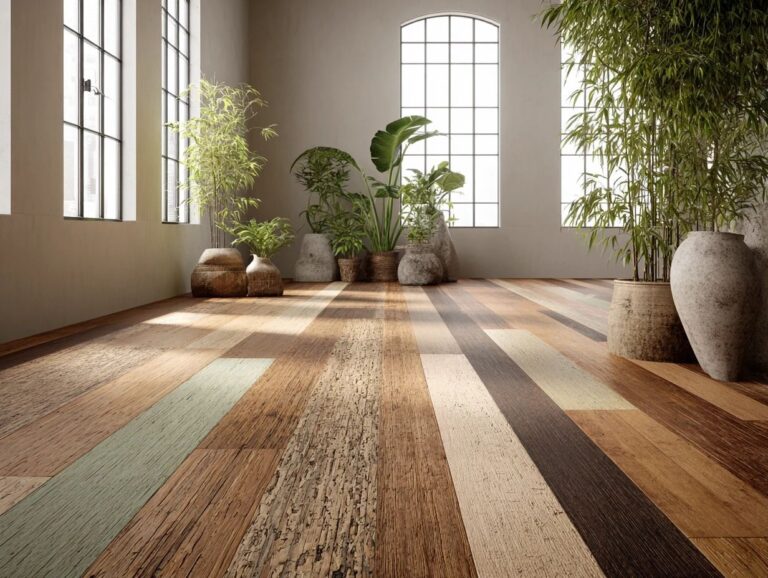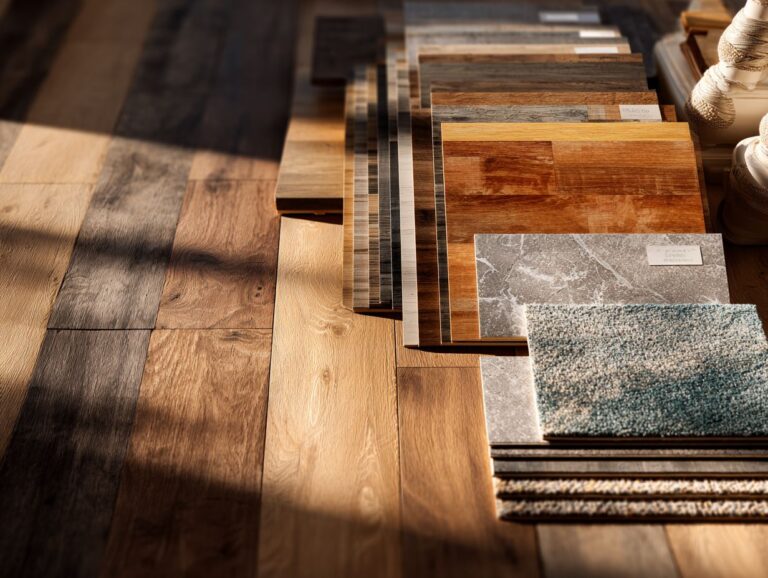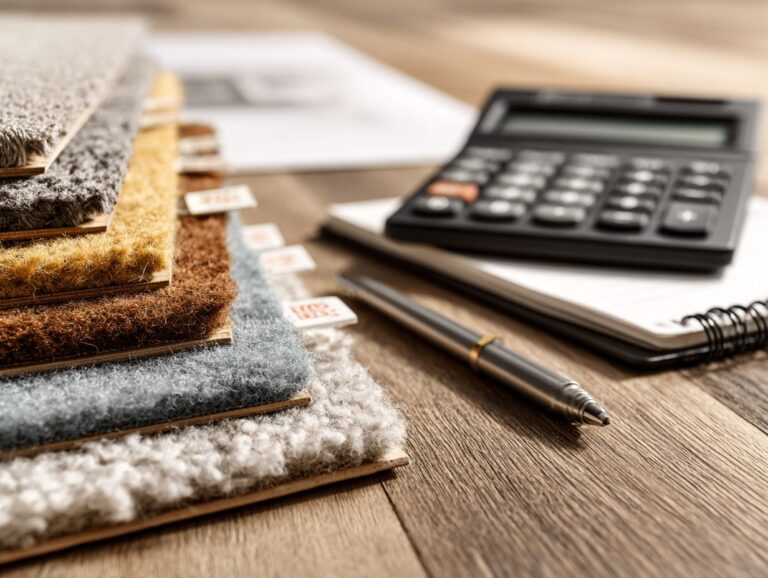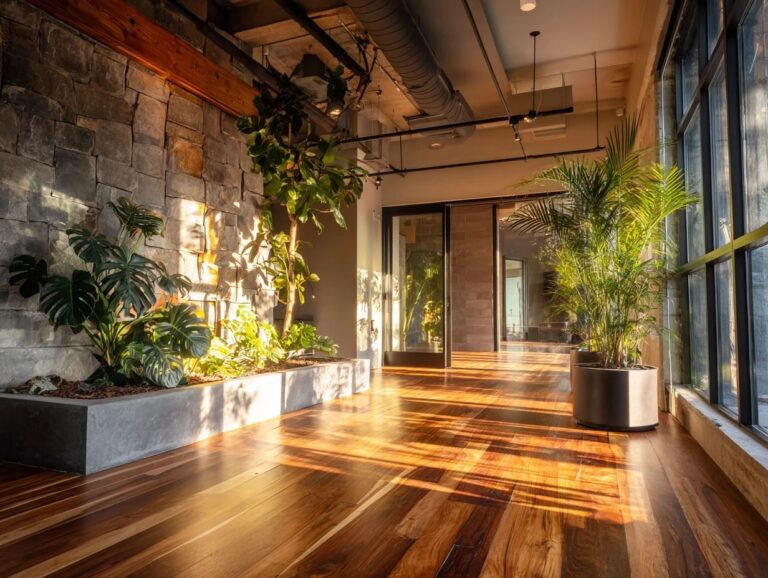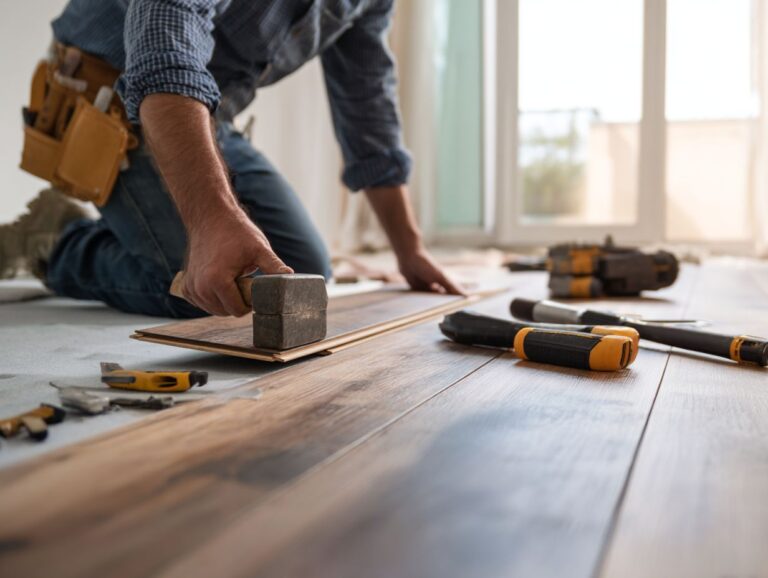Laundry Room Flooring – Handling Water and Chemicals
Contents
- Introduction to Laundry Room Flooring
- Water Resistance in Flooring
- Laundry Room Flooring Durability Stats
- Chemical Resistance in Flooring
- Types of Flooring Materials
- Installation Considerations
- Long-Term Care and Maintenance
- Frequently Asked Questions
- What type of flooring is best for a laundry room that deals with a lot of water and chemicals?
- Is it necessary to use a sealant on laundry room flooring?
- Can I use carpet or hardwood flooring in my laundry room?
- How often should I clean and maintain my laundry room flooring?
- What should I do if there is a spill of bleach or other harsh chemicals on my laundry room flooring?
- Can I install laundry room flooring myself or should I hire a professional?
Introduction to Laundry Room Flooring

Key Takeaways:
Importance of Choosing the Right Flooring
Choosing the right flooring for the laundry room is important because it needs to last a long time and resist moisture. This is essential in areas with heavy machines such as washers and dryers.
Opt for materials like vinyl or ceramic tile that are designed to withstand spills and high humidity.
Vinyl is particularly effective, providing a cushioned surface that’s easy to clean and comes in various styles. Ceramic tile is a durable option that provides slip resistance. It’s important to seal it correctly to avoid grout stains.
For maintenance, consider a textured surface that minimizes dirt visibility and allows for easy mopping. Using a gentle soap for regular cleaning will help your laundry room last longer and look clean.
Overview of Common Flooring Materials
Common flooring materials for laundry rooms include vinyl, ceramic, porcelain, laminate, and natural stone, each with unique benefits and drawbacks.
Vinyl is well-liked because it is water-resistant, budget-friendly, and simple to install, which makes it ideal for do-it-yourself projects.
Ceramic and porcelain tiles are durable and resistant to moisture but can be colder underfoot. For spaces like kitchens and laundry rooms, where water resistance is crucial, see also Kitchen Flooring Options – Water Resistance and Style for more insights.
Laminate offers a warm feel with a variety of styles, though it may not be fully waterproof and requires careful maintenance.
Natural stone, such as slate or granite, adds elegance and durability but can be pricier and may need sealing for moisture resistance.
Think about how much money you want to spend and what looks you like when deciding.
Water Resistance in Flooring
Knowing how well flooring resists water is important when choosing materials, as laundry rooms often have spills and moisture. To explore waterproof and slip-resistant flooring options, you might find our guide on bathroom flooring to be particularly insightful.
Understanding Water Damage
Water damage can ruin floors, resulting in expensive fixes and health dangers due to mold and mildew.
Many laundry rooms often face similar types of water damage. For instance, leaks from washing machines, often resulting from worn hoses or loose connections, can lead to significant pooling.
A study by the Insurance Institute for Business & Home Safety notes that approximately 14,000 people experience a water damage emergency daily, underscoring the necessity of preventative measures.
To mitigate risks, consider installing water-resistant materials such as vinyl or tile flooring, which can withstand moisture better than traditional options.
Check hoses regularly for any damage and replace them every three to five years to avoid leaks.
Laundry Room Flooring Durability Stats
Laundry Room Flooring Durability Stats
Flooring Options Durability: Durability Percentage
Flooring Options Durability: Cost ($)
The Laundry Room Flooring Durability Stats Give a clear summary of the strength and price of different flooring choices, important for choosing the best material for laundry rooms. This analysis considers both longevity and financial aspects, helping consumers balance durability with budget constraints.
Flooring Options Durability shows that Vinyl Sheeting leads with a durability score of 90% This makes it a preferred option for places that need to withstand water and frequent use. At a moderate cost of $300 It provides great worth because of its long-lasting nature, making it a good choice for consumers who want reliable function without spending too much.
- Terra Cotta and Ceramic Tiles both score 85% on durability. Terra Cotta is priced at $500, while Ceramic Tiles cost $700. They are ideal for those who prefer a classic aesthetic and are willing to invest slightly more for longevity and style.
- Porcelain Penny Tile follows with an 80% durability rating, priced at $600. This option merges style with durability, suitable for homeowners who desire a unique design with dependable performance.
- With a 75% durability score, Slate or Stone Tiles are the priciest at $800, reflecting their premium nature. They are an ideal choice for those prioritizing a natural stone look and longevity in high-traffic areas.
- Wood-Look Vinyl Planking offers a 70% durability rating at $400. It provides an affordable alternative to hardwood with a similar appearance, suitable for those who desire wood aesthetics without the high cost.
- Hardwood Oak or Maple scores 60% in durability and costs $1000 This makes it a top choice because it is less affected by moisture. Its appeal lies in its natural beauty and warmth, preferred by those prioritizing aesthetics over durability in areas with less moisture exposure.
- Linoleum, with a 50% durability rating and cost of $200, is the least durable, suitable for budget-friendly projects where high traffic and moisture are less of a concern.
The analysis of Laundry Room Flooring Durability Stats highlights the trade-offs between cost and durability across different flooring materials. Consumers must consider the specific requirements of their space, such as moisture exposure and aesthetic preferences, to make an informed choice that aligns with their budget and performance expectations.
Waterproof vs. Water-Resistant Flooring

Waterproof flooring is impervious to moisture, while water-resistant flooring can withstand spills for a limited time before suffering damage.
Luxury vinyl plank (LVP) is a type of waterproof flooring, ideal for rooms with lots of moisture, such as bathrooms and basements.
Laminate flooring, which resists water, can work in kitchens, but clean up spills quickly to prevent damage. Related insight: Kitchen Flooring Options – Water Resistance and Style
When choosing between them, consider your environment: opt for LVP in wet locations for long-lasting durability, while laminate can work well in drier areas where the risk of water exposure is minimal.
Best Practices for Water Management
Implementing best practices for water management is essential to prolonging the life of your laundry room flooring.
- Start by installing waterproof underlayments to shield the floor from moisture. Consider using area rugs to absorb spills, as they can be easily machine-washed and replaced.
- Reduce humidity by using an exhaust fan or keeping windows open for good airflow. Regularly check for leaks in appliances and pipes to prevent water accumulation.
- Consider applying a sealant to the floor every few years to make it more water-resistant. This proactive approach will help maintain your laundry room’s flooring and prevent costly repairs.
Chemical Resistance in Flooring
Laundry room floors need to resist chemicals because they regularly come into contact with different soaps and cleaners. For an extensive analysis of suitable flooring materials, our comprehensive guide on epoxy flooring systems examines durability and chemical resistance in residential applications.
Common Chemicals in Laundry Rooms
Common chemicals found in laundry rooms include detergents, fabric softeners, bleach, and various cleaning agents that can affect flooring longevity.
Each of these chemicals poses unique risks to different types of flooring. For example, bleach can discolor vinyl and laminate, while strong detergents may break down the adhesion of tiles.
To protect your floors, consider using chemical-resistant mats in high-traffic areas. Choosing materials like porcelain tiles or sealed hardwood can increase strength and longevity. Regularly applying a protective sealant can also help mitigate chemical damage, extending the life of your flooring significantly.
Always review product labels for compatibility with your flooring type to minimize risks.
Choosing Chemical-Resistant Materials
Selecting chemical-resistant materials, such as ceramic tiles or luxury vinyl, can help mitigate wear and tear in laundry rooms.
To pick the most suitable flooring for your laundry room, think about these things:
- Resistance to chemicals like bleach and detergent
- Durability under heavy use
- Ease of cleaning
Products like Sherwin-Williams’ Resilient Flooring offer a wide range of options known for their chemical resistance and durability. Check out their Epoxy Flooring options, which offer a smooth surface that is resistant to strong chemicals and easy to keep clean. Doing a first test for how slippery a surface is can be important for keeping things safe.
Maintenance and Cleaning Considerations
Regular upkeep and cleaning are important for keeping laundry room floors intact, especially when they come into contact with chemicals.
To effectively clean various flooring types, consider these strategies.
- For tile floors, use a pH-neutral cleaner to avoid discoloration, and scrub with a soft brush to prevent scratching.
- Vinyl requires a similar approach; opt for a mixture of vinegar and water, ensuring no harsh abrasives are used.
- For laminate flooring, a damp mop with a mild detergent will work wonders without causing damage.
Regularly look for spills and clean them up quickly to keep your flooring in good condition for a long time.
Types of Flooring Materials
There are many types of flooring choices, each with specific benefits for use in laundry rooms.
Vinyl Flooring
Vinyl flooring is a popular choice for laundry rooms due to its affordability, waterproof capabilities, and ease of installation.
Among the different types of vinyl flooring, luxury vinyl plank (LVP) stands out. LVP mimics the look of hardwood, providing an upscale appearance while being more resistant to moisture and wear.
For installation, consider using a click-lock system, which allows for easy DIY setup in just a few hours. Prepare the subfloor by ensuring it’s clean and level, and use underlayment for extra cushioning and sound absorption.
This focus on detail can improve the look of your laundry room while ensuring it stays strong.
Ceramic and Porcelain Tiles

Ceramic and porcelain tiles are strong and resist slipping, which makes them perfect for busy laundry rooms.
While both tile types serve well in laundry spaces, they have distinct characteristics.
Ceramic tiles usually have a porous surface and are easy to cut, which makes them simpler and cheaper to install. They are available in a wider range of colors and patterns, offering greater aesthetic flexibility.
Porcelain tiles are very water-resistant and dense, so they are perfect for places where spills happen often. Their denser composition allows for minimal fading and staining, ensuring longevity.
Consider your local climate and maintenance preferences when choosing between these materials.
Laminate Flooring
Laminate flooring represents a budget-friendly alternative that mimics the appearance of wood or stone while providing easy maintenance.
In a laundry room, laminate flooring excels due to its water resistance and durability. Unlike traditional hardwood, which can warp from spills, laminate is designed to withstand moisture.
For example, choosing a laminate with an AC rating of 4 or higher guarantees strong performance in areas with heavy foot traffic and water exposure.
Brands like Quick-Step and Pergo offer specific lines ideal for such environments. Using a waterproof layer can help prevent leaks, making laminate a suitable option for areas that get wet often.
Concrete Flooring
Concrete flooring is a durable option that can withstand heavy traffic and offers a seamless transition into laundry areas.
Its resistance to water and chemicals makes it an ideal choice for laundry rooms, where spills and moisture are common.
Many homeowners seal concrete to improve water resistance and minimize stains, using products such as epoxy or polyurethane sealants.
It’s worth noting that concrete can feel cold underfoot and may retain moisture, which can affect comfort over time.
To mitigate this, consider adding area rugs or underfloor heating systems, ensuring warmth and comfort without compromising on durability.
Carpet Tiles
Carpet tiles provide comfort and sound dampening but require careful consideration in moisture-prone laundry environments.
In areas with high humidity, such as laundry rooms, carpet tiles can be susceptible to mold and mildew. To mitigate this, consider using moisture-resistant tiles specifically designed for such conditions.
For example, look for tiles made from vinyl or rubber, which are less absorbent and easier to clean. Regularly vacuuming and using a damp mop can help maintain the surface, while incorporating an effective dehumidifier can control moisture levels, creating an environment that reduces mold risk while allowing you to enjoy the comfort of carpet tiles.
Installation Considerations
Correct installation is necessary to make your laundry room flooring last and work well.
Preparing the Subfloor
Getting the subfloor ready is important for installing flooring correctly. It helps avoid problems with moisture and damage to the structure.
- Start by checking moisture levels with a moisture meter; readings above 12% indicate a potential problem.
- Next, level the subfloor using a self-leveling compound, particularly if there are dips or uneven areas that could affect the flooring installation.
- To achieve good insulation, put in rigid foam boards or mineral wool. Improves energy use while reducing noise spread.
- Each of these steps is important for building a strong base, which in turn extends the life of your flooring.
Professional vs. DIY Installation
Deciding between professional installation and a DIY approach can significantly impact your project’s cost and outcome.
Professional installation offers expert service and guarantees, costing between $2 and $5 per square foot, depending on the difficulty of the work. For example, hiring a qualified contractor for a kitchen remodel can help meet local regulations and achieve a professional look.
In contrast, a DIY approach allows you to save on labor costs, with materials alone ranging from $1 to $3 per square foot. This approach fits homeowners who are sure of their abilities, but it might need extra time and work to gather information and complete the process.
Assess your budget and skill level to determine which route suits you best.
Long-Term Care and Maintenance
You should regularly clean and care for your laundry room floor to keep it in good shape and working well.
Routine Cleaning Tips

Regular cleaning can help keep your laundry room floor in good condition, both in how it looks and how it works.
For vinyl flooring, sweep daily and use a gentle mop with a solution like pH-neutral cleaner weekly.
Tile floors should be thoroughly cleaned each month with tile cleaning products. To care for laminate, dust regularly to prevent scratches. Use a damp cloth to clean every two weeks, ensuring you don’t use too much water.
To keep concrete clean, scrub it with a mixture of water and baking soda every two months to stop stains.
By setting up these routines, you can increase the long-lasting quality and keep the visual attractiveness of each flooring type.
Repairing Damage
Knowing how to repair damage to your laundry room flooring can save both time and money, ensuring your space remains functional.
Common types of damage include cracks in tiles, worn-out vinyl, and laminate scratches.
For tile damage, consider replacing individual tiles using a chisel and adhesive, with costs around $5-$15 per tile.
If dealing with vinyl flooring, small tears can often be fixed with a vinyl flooring repair kit, typically priced at $20-$30.
For laminate scratches, use a touch-up marker or laminate repair kit, averaging $10-$20.
Using sealants can help protect surfaces and decrease wear over time. A gallon of sealant costs between $30 and $50, depending on the brand.
Final Thoughts on Flooring Choices
The best flooring for your laundry room will be based on what you need, what you like, and how much you want to spend.
To make an informed decision, consider these key factors: moisture resistance, durability, and maintenance.
For example, luxury vinyl tiles don’t get damaged by water easily and are simple to clean, so many people choose them. If you prefer a more natural look, bamboo flooring offers both durability and eco-friendliness. Laminate flooring can be a budget-friendly option, providing decent water resistance and varied designs.
Consider these choices in relation to your laundry room’s design and how you use the space. Talk to flooring professionals like Murnane Floors for advice suited to your needs.
Frequently Asked Questions
What type of flooring is best for a laundry room that deals with a lot of water and chemicals?
The best flooring for a laundry room that deals with water and chemicals is vinyl or ceramic tile. These materials are water-resistant and can withstand exposure to harsh chemicals without damage.
Is it necessary to use a sealant on laundry room flooring?
Yes, it is highly recommended to use a sealant on laundry room flooring to prevent water and chemical damage. Sealants provide an extra layer of protection and can also make cleaning up spills easier.
Can I use carpet or hardwood flooring in my laundry room?
No, carpet and hardwood are not suitable for laundry room flooring. They are not water-resistant and can be easily damaged by exposure to chemicals. It is best to use a more durable and water-resistant material such as vinyl or tile.
How often should I clean and maintain my laundry room flooring?
It is recommended to clean and maintain your laundry room flooring at least once a week. This includes mopping up any spills and using a mild cleaner to remove any built-up grime or dirt. Regular maintenance will help prolong the life of your flooring.
What should I do if there is a spill of bleach or other harsh chemicals on my laundry room flooring?
If a spill of bleach or other harsh chemicals occurs, it is important to act quickly. Wipe up the spill immediately and rinse the area with water. Avoid using any abrasive cleaners or tools that may damage the flooring.
Can I install laundry room flooring myself or should I hire a professional?
It is possible to install laundry room flooring yourself, but it is recommended to hire a professional for a more durable and long-lasting installation. A specialist can make sure the flooring is sealed correctly to guard against water and chemical damage.
